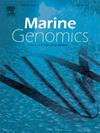Genomic analysis of Marinobacter flavimaris ZYH30 reveals its role in marine dimethylsulfide cycling
IF 1.5
4区 生物学
Q4 GENETICS & HEREDITY
引用次数: 0
Abstract
Dimethylsulfide (DMS) is a volatile organic compound that influences climate change and plays a key role in the global sulfur cycle and chemotaxis. Marine bacteria can produce DMS from dimethylsulfoniopropionate (DMSP) and other sulfur precursors. A highly efficient DMS-producing strain, Marinobacter flavimaris ZYH30, was isolated from the surface sediment of the South China Sea, but the key genes involved in DMS production in its genome remain unknown. Here, we reported the complete genome sequence of M. flavimaris ZYH30 and its genomic potential in DMS cycling. The genome of M. flavimaris ZYH30 consists of a circular chromosome with a length of 4,631,282 bp and its GC content is 57.26 %. Genomic analysis showed that strain ZYH30 possesses a set of genes involved in DMS cycling, including a DMSP lyase DddL. In addition, M. flavimaris ZYH30 contained a mddH gene involved in hydrogen sulfide (H2S) and methanethiol (MeSH) dependent DMS production pathways. This study provides genetic insights into the DMS production processes and sulfur cycling in marine sediment bacteria.
海洋黄杆菌ZYH30基因组分析揭示其在海洋二甲硫循环中的作用
二甲基硫(DMS)是一种影响气候变化的挥发性有机化合物,在全球硫循环和趋化性中起着关键作用。海洋细菌可以从二甲基磺酰丙酸酯(DMSP)和其他含硫前体生产DMS。从南海表层沉积物中分离到一株高效产DMS的黄Marinobacter flavimaris ZYH30,但其基因组中与DMS生产相关的关键基因尚不清楚。本文报道了黄芽孢杆菌ZYH30的全基因组序列及其在DMS循环中的基因组潜力。黄毛霉ZYH30基因组由一条长4,631,282 bp的环状染色体组成,GC含量为57.26%。基因组分析表明,菌株ZYH30具有一组参与DMS循环的基因,包括DMSP裂解酶DddL。此外,M. flavimaris ZYH30含有一个mddH基因,参与硫化氢(H2S)和甲硫醇(MeSH)依赖的DMS生产途径。该研究为海洋沉积物细菌的DMS生产过程和硫循环提供了遗传学见解。
本文章由计算机程序翻译,如有差异,请以英文原文为准。
求助全文
约1分钟内获得全文
求助全文
来源期刊

Marine genomics
生物-遗传学
CiteScore
3.60
自引率
5.30%
发文量
50
审稿时长
29 days
期刊介绍:
The journal publishes papers on all functional and evolutionary aspects of genes, chromatin, chromosomes and (meta)genomes of marine (and freshwater) organisms. It deals with new genome-enabled insights into the broader framework of environmental science. Topics within the scope of this journal include:
• Population genomics and ecology
• Evolutionary and developmental genomics
• Comparative genomics
• Metagenomics
• Environmental genomics
• Systems biology
More specific topics include: geographic and phylogenomic characterization of aquatic organisms, metabolic capacities and pathways of organisms and communities, biogeochemical cycles, genomics and integrative approaches applied to microbial ecology including (meta)transcriptomics and (meta)proteomics, tracking of infectious diseases, environmental stress, global climate change and ecosystem modelling.
 求助内容:
求助内容: 应助结果提醒方式:
应助结果提醒方式:


